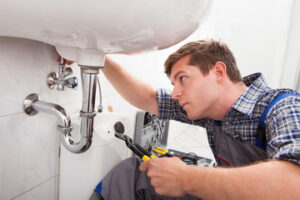Plumbing is one of the most essential services that keep your home or office running smoothly. It provides clean water and disposes of waste. It also protects your health and safety by preventing the buildup of dangerous bacteria and chemicals. Contact Got Flow Plumbing & AC Services for professional help.

A plumbing plan shows the layout of a building’s water supply, drain, vent, and fixture units. It also indicates pipe sizes and their locations.
Plumbing has a long and varied history. It was a critical element of ancient civilizations, with the first plumbing systems allowing for public bathing, wastewater removal and potable water. These were often very basic in design, however. It wasn’t until the 1800s that indoor plumbing really took off in America.
Until then, cities would let disease-carrying raw sewage run through their streets, which not only made life miserable for the residents but also contaminated the clean water supply. In fact, many people lost their lives during these times not from war wounds but from diseases related to poor sanitation and dirty water.
As the need for safe, reliable plumbing became apparent, engineers and plumbers began to develop more advanced techniques. By the 1920s, there were three documents (BMS 65, Methods of Estimating Loads in Plumbing Systems; BMS 66, Plumbing Manual; and BMS 79, Water Distributing Systems for Buildings) that served as the basis for all modern plumbing codes. These were not federally mandated, however, as the federal government viewed construction projects as a local issue.
At around the same time, researchers at the National Bureau of Standards were working on standardization for products, including plumbing fixtures and pipes. This effort was led by Dr. Roy B. Hunter, whose research is credited with the development of the first national plumbing code. It is often referred to as the “Hoover Code,” not because of President Hoover’s support of this project but because it was initially overseen by the Commerce Department, which was controlled by Hoover at that time. The code set forth many important principles that remain in place today, including:
Skills
Plumbers use a variety of tools and techniques to install, repair, and maintain plumbing systems. They need to have strong problem-solving skills to identify and resolve issues quickly and efficiently. They also need to have good customer service skills to interact with clients and other professionals effectively. A friendly demeanor can go a long way in building trust and ensuring customer satisfaction.
Plumbers must be able to read and interpret blueprints and technical drawings, which are used to plan the layout of pipe installations and ensure that they meet specifications and codes. They must also be able to work with a variety of materials, including copper, steel, and PVC. Plumbers also need to be familiar with various types of plumbing fixtures, such as faucets, toilets, showers, and sinks.
Good physical fitness is important for plumbers, who often need to be able to bend, lift, and maneuver large pipes and other equipment. They also need to be able to work in tight spaces and at heights. A plumbing course will teach students how to safely operate tools like pipe wrenches, cutters, and soldering irons.
As plumbing technology advances, plumbers must be able to adapt and learn new skills. For example, many plumbers are now using advanced digital technologies to detect and locate leaks in hidden areas. They also need to be familiar with new water-saving fixtures and appliances, such as digital showers, hands-free faucets, and programmable toilets. Additionally, plumbers need to be able to identify and understand the risks associated with working with hazardous materials. They must also adhere to strict safety protocols when working in high-use commercial environments. They must be able to communicate with others in the workplace and with customers about these risks.
Education
There are many opportunities for those who want to pursue a career in the plumbing profession. A formal educational program is the best route to a rewarding career. It will give you a leg up on the competition, because it includes a mix of academic and technical coursework. It also includes supervised training and practical application of the skills learned in class.
A plumbing program will teach you how to install, test, and repair pipes that carry water, gas, or other liquids to and from homes, businesses, and factories. You will learn to read blueprints, use tools to join different types of pipe materials, and follow state and local codes. You will also learn about basic engineering and math, which are essential for a successful career in the field.
After completing a plumbing program, you will be ready to start an apprenticeship. You will be able to apply your new skills and earn a living while you learn the trade. You can choose from a variety of programs, including those offered by community colleges. These programs include hands-on practice in real-life settings and can help you get a job as a plumber.
Many states require a minimum of four years of experience to become licensed as a journeyman plumber. Some programs allow students to earn certification in specific areas of the field, such as green plumbing design. Many students also earn college credits by completing this program. This can be a valuable addition to your resume and may open doors to future employment opportunities.
In this four-year program, you will learn how to install and repair plumbing and heating systems in residential, commercial, and industrial buildings. You will also learn how to make repairs to existing plumbing fixtures, such as toilets and faucets. In addition, you will learn to design and build plumbing systems. You will also learn to work with a wide variety of materials and equipment, such as PVC, PEX, and copper.
Certification
Whether they work in a home, office, or factory, plumbers install, maintain and repair the piping systems that keep modern society running. The skills and training required to be a successful plumber vary by state, but most require at least a high school diploma and completion of a plumbing program from a certified trade school. The programs offer practical, hands-on experience to prepare students for the industry and ensure a high level of proficiency. They cover topics like math, blueprints, and code to give students a solid foundation for their future careers.
Licensing requirements also vary by state, and the specific rules can depend on what type of plumbing you want to pursue. However, the majority of states have three main levels of licensing: apprentice, journeyman, and master plumber. The apprentice path is the most common, and typically involves four years of supervised training under a journeyman. After gaining experience, you can become a journeyman, and then eventually a master plumber after additional years of work.
The final step is to pass the state exam. This can be a difficult test, but practice can help you feel confident and ready to take it. The best way to prepare is to enroll in a license prep course and practice taking sample exams. This will give you the practice and confidence needed to successfully pass your state’s test and begin working as a licensed plumber.
In addition to licensing and certification, plumbing professionals should also maintain adequate insurance coverage and be bonded. This will protect clients and employees in the event of accidents or injuries, and will prevent financial losses if the plumbing professional fails to complete their work.
Reputation
The reputation of a plumber plays a crucial role in building credibility and winning new business. As many prospective customers research options online, they compare reviews and ratings to assess service quality. They may also look into the company’s longevity to gauge reliability and trustworthiness. A well-established plumbing outfit likely has a long list of satisfied clients. They probably use the best equipment and have established relationships with suppliers, allowing them to offer competitive pricing. They may also have more experience with plumbing problems than brand-new outfits that are still developing capabilities and overcoming learning curves.
The overwhelmingly positive customer appraisals of Fergusons Plumbing’s reasonable rates, responsiveness and professionalism speak to their reputation as a premier provider. Their dedication to delivering exceptional plumbing services has earned them remarkable client loyalty, further bolstering their stellar standing. Their commitment to continually adopting industry advances and incorporating them into their offerings further supports their reputation as an innovative leader in the field.
Plumbers that make generating online reviews a priority can greatly improve their visibility, search engine optimization (SEO) and conversion. Review management software, such as DataPins, automates review requests and sends them to recently serviced clients through email or text. This helps them overcome the common problem of getting a solid response rate, which is the reason most businesses fail to generate enough reviews. This type of social proof is recognized by Google as authentic content and enhances SEO and local rankings.
